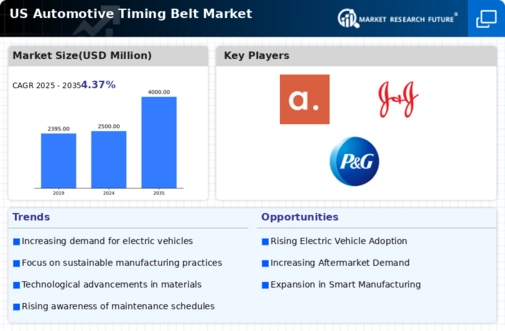Rising Vehicle Production
The automotive timing-belt market experiences growth driven by the increasing production of vehicles in the US. In recent years, the automotive industry has seen a resurgence, with production levels reaching approximately 10 million units annually. This surge in vehicle manufacturing necessitates a corresponding demand for essential components, including timing belts. As manufacturers strive to meet consumer demand, the automotive timing-belt market benefits from the heightened need for reliable and durable parts. Furthermore, the trend towards more complex engine designs, which often require advanced timing-belt systems, further propels market growth. The automotive timing-belt market is thus positioned to capitalize on this upward trajectory in vehicle production, ensuring a steady supply of components to support the expanding automotive sector.
Regulatory Standards and Compliance
The automotive timing-belt market is also shaped by stringent regulatory standards aimed at improving vehicle safety and emissions. In the US, regulations set forth by agencies such as the Environmental Protection Agency (EPA) and the National Highway Traffic Safety Administration (NHTSA) compel manufacturers to adopt higher quality components, including timing belts. Compliance with these regulations often necessitates the use of advanced materials and manufacturing processes, which can drive up demand for high-quality timing belts. Consequently, the automotive timing-belt market must adapt to these evolving standards, ensuring that products meet or exceed regulatory requirements while maintaining competitive pricing.
Growth of the Electric Vehicle Segment
The automotive timing-belt market is experiencing a shift due to the growth of the electric vehicle (EV) segment. Although electric vehicles do not utilize traditional timing belts in the same manner as internal combustion engine vehicles, the increasing prevalence of hybrid models still requires timing belts for their combustion engines. The EV market in the US is projected to grow at a compound annual growth rate (CAGR) of approximately 20% over the next five years. This growth presents an opportunity for the automotive timing-belt market to innovate and adapt its offerings to cater to the evolving needs of hybrid and traditional vehicles alike.
Technological Innovations in Materials
The automotive timing-belt market is influenced by advancements in materials technology, which enhance the performance and durability of timing belts. Innovations such as the development of high-strength synthetic materials and advanced rubber compounds have led to products that can withstand higher temperatures and stress levels. This evolution in material science not only improves the lifespan of timing belts but also aligns with the automotive industry's push for more efficient and reliable components. As a result, the automotive timing-belt market is likely to see increased adoption of these advanced products, which can offer better performance and lower maintenance costs for consumers.
Increased Vehicle Maintenance Awareness
There is a growing awareness among vehicle owners regarding the importance of regular maintenance, which significantly impacts the automotive timing-belt market. As consumers become more informed about the role of timing belts in engine performance and longevity, they are more likely to adhere to recommended replacement schedules. This trend is reflected in the rising aftermarket services sector, which has seen a growth rate of approximately 5% annually. The automotive timing-belt market stands to benefit from this shift, as timely replacements and maintenance can prevent costly engine failures. Additionally, educational campaigns by automotive organizations further emphasize the necessity of maintaining timing belts, thereby driving demand within the market.














Leave a Comment